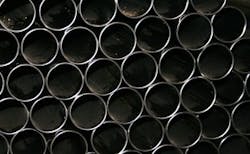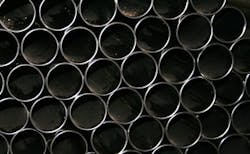German company i3 Membrane has attracted investment and is gearing up for a product launch of its steel membranes next year. How does the technology work? How does it compare with traditional polymeric membranes? What are the prospects for its future commercialisation?
By Andrew Williams
The market for traditional polymeric-based ultrafiltration (UF ) and microfiltration (MF) membranes first took off in water and wastewater applications in 1998.
Yet, as Graeme Pearce, director of Membrane Consultancy Associates explains, it took until 2006 before the technology was first used for seawater reverse osmosis (SWRO) desalination pre-treatment, largely because it was considered "unnecessary and too expensive".
Since then though, Pearce reveals that RO has grown quite strongly and the importance of polymeric-based UF and MF pre-treatment has taken a "progressively larger share of the growing market". In an effort to grab a slice of this market, a number of alternative membrane technologies have also been developed in recent years - with ceramic membranes emerging as a possible contender.
Now, German company i3 Membrane has secured investment for its innovative steel membrane technology, prior to a planned product launch next year. According to the company, the newly developed "high-tech membrane" is made from high-quality steel, and benefits from being "more stable and more flexible" than the polymer-based filters that are typically used today.
The company also claims that the innovation is more environmentally friendly in view of the fact that the manufacturing process only requires a combination of inert gas and electrical power, eliminating the need to use toxic chemicals.
As Dr. Stephan Brinke-Seiferth CEO at i3 Membrane, explains, the underlying technology of the system is Plasma Immersion Ion Implementation (PIII), which he reveals has been developed alongside Prof. Andreas Kolitsch at the Helmholtz-Zentrum Dresden-Rossendorf (HZDR), a German research laboratory in Dresden and member of the Helmholtz Association of German Research Centres.
Within the system, inert gas ions, for example Helium ions, are "created in a plasma and accelerated towards a negatively charged substrate" - in this case a metal film. Brinke-Seiferth says that this process leads to the incorporation of Helium ions within the metal, which, "under sustained experimental conditions" causes the enrichment and vesication, or blistering, of Helium under the metal surface - thus "inducing a porosity of the metal".
Put simply, this means that the manufacturing process begins by accelerating a large number of electrically charged atoms of an inert gas - before implanting them in "high-quality steel foil". The accumulation of these atoms results in the formation of miniature bubbles in the foil, eventually leading to the formation of larger pores.
Brinke-Seiferth highlights the fact that most types of membrane technology were initially invented during the 1960s - and that their performance has not "significantly changed" since then. For him, the "critical limitations" of most existing examples of such filtration technology are that it is vulnerable to chemical contamination by the "wash-out" of membrane materials via extractables and leachables - and that it is over-sensitive to chemicals and "unwanted adsorption effects".
In view of the fact that it eliminates the need for chemicals, the process has also secured backing from the Deutsche Bundesstiftung Umwelt (Federal German Environment Foundation) via a grant of EUR 250,000. An initial product launch, currently slated for June 2015, will focus on the "preparation of samples for analysis of trace substances" - and the company has publicly announced that the field of application "will later be widened to include other uses in biotechnology and also in the field of water purification".
However, as Brinke-Seiferth explains, the first application of the developed membrane technology will be for quality assurance testing in the manufacturing of pharmaceuticals. According to him, this process calls for an "extremely pure and contaminant-free preparation of samples" to allow for "highly sensitive downstream analysis methods".
"Filtration is a common requirement during sample processing," he says. "However, [it] is also a major contributor to introduced impurities, severely compromising the precision of the overall analysis. Most available filter membranes are made from polymers that require the use of solvents as part of the membrane production process. Solvent residues remain attached to the filter membrane until use, leading to a washout of so called leachables and extractables that alter or inhibit precise read-outs in down-stream analyses."
As well as pharmaceuticals, the company is also targeting a number of other potential industries - and has identified water treatment as one of the key future applications of the technology.
For Brinke-Seiferth, a key advantage of the new i3 Membrane filter technology is that the metal filter membranes will overcome current problems with the wash-out of "contaminants such as extractables and leachables associated with polymer filter membranes".
In his view, they will also "greatly simplify and improve" the cost effectiveness of laboratory processes involving filter membranes - for example by cutting down on the "hands-on time" needed. He says they will "supersede the current highly fragmented polymer membrane filter offering" by being "universally usable and superior in terms of filtration efficiency, stability and ‘robustness against the most commonly used chemicals and operating temperature ranges".
With one eye towards the long-term development and commercial scale-up of the technology, the i3 Membrane project team is currently focused on research aimed at overcoming a number of ongoing technical challenges. As Brinke-Seiferth explains, says: "As soon we scale up the membrane production we will enter the whole water treatment market step by step. Because i3 membrane developed a new platform technology it is a long term business," he adds.
In the opinion of one seasoned industry observer, Brent Giles, senior analyst at Lux Research, i3 Membranes is very similar to Metal Membranes, another early stage company with a similar technology. For him, the technology being developed by these companies has been limited in the past because "these types of membranes haven't been manufacturable roll-to-roll, and haven't had enough pore density for high flux".
In terms of potential initial applications, Giles agrees that the pharmaceuticals industry, as well as a select few others, could well emerge as fruitful areas for commercialisation.
At this stage, Giles is sceptical about the prospects for the future roll out and commercialisation of the i3 Membrane technology in the water purification and treatment industry. However, he believes that it could emerge as a viable alternative to polymer membrane technology in some niche markets.
"Membranes generally are well suited to remove small concentrations of contaminants efficiently," he says. "High concentrations tend to foul them. Since the dominant polymer membrane technology is fragile and tends to fail under strong chemical cleaning, the industry sometimes falls back on older solutions like ceramics despite their high cost. Metal membranes have the potential to replace ceramics in these niche industrial markets," he adds.
For Pearce, a 'critical' benefit of ceramics is ‘guaranteed integrity,' which he believes provides a more reliable barrier to micro-organisms, such as cryptosporidium, bacteria and viruses.
"Since this is a critical performance parameter for the municipal segment, it is almost inevitable that ceramics will eventually win over polymerics. Polymerics will always be prone to occasional failure, especially during operational upsets such as feed excursions or equipment failure, and so will always require integrity testing," he says.
"I think that a new steel membrane is likely to be best suited for niches and is unlikely to break into general use, even though ceramics could."
Author's note: The full version of this article will appear online at www.wwinternational.com. Andrew Williams is freelancer contributor for WWi. For more information on the article, email: [email protected]
More Water & WasteWater International Archives Issue Articles




